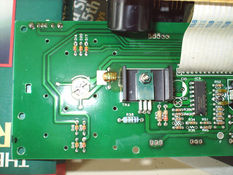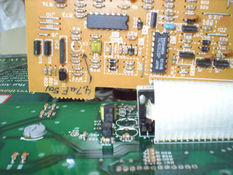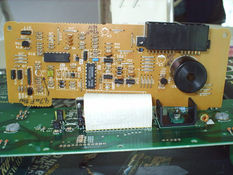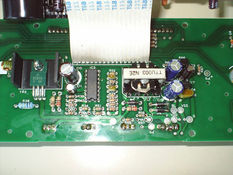Electrical: Replace ECU, ECS and Climate Control Capacitors
Contents
- 1 Where to Purchase Capacitors
- 2 Signs of a Bad Capacitor
- 3 Tools Required
- 4 Replace Climate Control Capacitors on a Mitsubishi 3000GT/GTO and Dodge Stealth
- 5 Replace ECS Capacitors on a Mitsubishi 3000GT/GTO and Dodge Stealth
- 6 Replace ECU/ECM Capacitors on a Mitsubishi 3000GT/GTO and Dodge Stealth
This article will teach you how to replace the ECU, ECS and digital climate control capacitors in a Mitsubishi 3000GT/GTO and Dodge Stealth. This maintenance is particularly useful if your stock capacitors have started to leak, which can be considered a fairly common occurrence for our cars as the years pass by. Leaky capacitors are most likely to be found on first generation 3S's (1991 through 1993), but are not unheard of for later years as our cars advance in age.
The good news is replacing these capacitors requires minimal tools and only the essential electrical knowledge to complete. The replacement capacitors are relatively inexpensive (less than a dollar each) and are fairly easy to find as well.
When shopping for replacement capacitors, make sure that they're rated for operating temperatures between -55°C to 105°C (-131°F to 221°F). Also be aware that many retailers offer longer life capacitors as well (2000-3000 hour), which may cost slightly more, but are completely acceptable to use if you wish.
Where to Purchase Capacitors[edit]
Most of the capacitors used in this tutorial were purchased from DigiKey.com using the listed part numbers below. Alternatively, some community members have also had luck finding similar capacitors locally as well (e.g. at Radio Shack).
Signs of a Bad Capacitor[edit]
How do you know if your capacitors have met their maker? There's a good chance you'll smell it -- it's not pleasant... unless you like the smell of rotting fish. For the digital climate control, you may notice that your screen no longer functions. Terribly annoying reactions tend to happen when the capacitors in your ECU/ECM begin to leak; intermittent starting problems, car will run poorly/stutter, and may eventually completely shut down.
When in doubt, simply pull the unit in question, open it, and take a look around the circuit board. If you see yellowish gunk, or even if you want to preemptively strike an aging capacitor that might begin to leak, then you've come to the right place for help!
Tools Required[edit]
- Phillips screwdriver
- Flathead screwdriver
- Soldering toolkit
- Solder w/ flux core
- Soldering iron
- Desoldering iron w/ integrated vacuum pump (or solder braid)
The image to the right shows the tools used for this guide.The desoldering braid wicker tape is the blue plastic circle thing with copper braid sticking out. The brown bottle is liquid flux (I initially used that to coat the wicker tape for easier sucking but I don't think it was necessary at all).
Replace Climate Control Capacitors on a Mitsubishi 3000GT/GTO and Dodge Stealth[edit]
| Qty | DigiKey PN | Product Information | Location(s) |
|---|---|---|---|
| 1 | P5528-ND | 47uF 16V | C4 |
| 1 | P5566-ND | 4.7uF 50V | C5 |
| 1 | P5570-ND | 47uF 50V | C9 |
| 1 | P5543-ND | 470uF 25V | C10 |
| 2 | P5134-ND | 10uF 16V | C11, C17 |
| 2 | P5541-ND | 220uF 25V | C14, C15 |
| Qty | DigiKey PN | Product Information | Location(s) |
|---|---|---|---|
| 3 | 1N4004 | 1 Amp (Generic) | D5, D6, D7 |
| Qty | DigiKey PN | Product Information | Location(s) |
|---|---|---|---|
| 1 | PPC1.0W-1CT-ND | 1.0 Ohm 1.0 Watt | R38 |
Access Digital Climate Control Unit[edit]
- Remove center vents. Use two flat head screw drivers to lift up the hidden tabs inside the vent and a third flat head screw driver to pull the vent out. This will give you access to the top screw holding the automatic climate control display.
- Remove radio and any trim that's in the way of the climate control display. The display has three screws holding it, I've circled it in red in the pictures below.
- Remove digital climate control display from the dashboard. It's difficult to remove the display out without scratching it, so I suggest putting masking tape on it. I didn't have any tape so I cut the useless white plastic piece that's hidden behind the radio trim. This makes removal much easier. Before you can remove your display unit out, you'll have to disconnect two connectors at the back and also move the black plastic box below it -- this black box is held on with four screws. I believe this black box is the climate control brain.
Access and Replace Capacitors[edit]
- Open the digital climate control by removing the 10 screws from rear of the unit. If your capacitors are indeed fried, you may begin to experience a burnt fishy smell.
- Pull internal circuit board from the case and remove the rubbery buttons. The rubbery buttons will likely fall off on their own, but it'd be wise to remove them regardless so that they don't accidentally get burnt by your hot soldering iron.
- Inspect the digital climate control's circuitry and display for visible damage. On the display itself, you may notice two burnt marks on the right (seen below). Don't be alarmed, apparently this is normal. On the circuitry, you will likely notice where the leaking occurred. In my case, capacitor c15 failed and leaked onto diodes D6 and D7, causing the writing on the diodes to burn off. Before continuing to the next step, take note of your capacitor's size, voltage rating and location. Also observe the capacitor's polarity as it must be soldered in the same direction. Write all this stuff down, take photos if needed.
- Desolder and remove the VFD (display). This particular task took me many hours and is easily the most difficult part of this project. I used the braid desolder method but would suggest using a better tool such as a desoldering iron with integrated vacuum pump to make the task faster/easier. If you can, try using an alligator clip on the leg of the VFD that you are desoldering to keep from heating up the display too much. Then, after desoldering as best you can, you'll need one hand to hold the circuit board, one hand to hold a soldering iron to all 3 pins of the one leg, one hand to gently apply pressure to the VFD away from the board, and one hand to pry the leg up at the same time. This is where you might want to call in a help of a friend.
- Solder in new diodes (if needed). Using new 1N4004 1 amp generic diodes, I replaced diodes D6 and D7. Polarity matters, so be sure to solder them in the same direction as mine.
- Solder in new resisters (if needed). Some people have reported R38 to be burned up. Here's a photo of a bag of 1 watt resisters being held up next to R38 to illustrate that the original resistors are probably a bit smaller than 1 watt rating.
- Solder in new capacitors. If you have any residue build-up under or around your old leaky capacitors, it is highly recommended that you clean it up. This stuff is corrosive and will surely cause issues if unaddressed.
- Re-solder your VCD back.
- Reassemble, reinstall and test the repaired climate control unit. You're good to go!
Other than that, in case you have other components damaged, here's some pictures of my display unit circuit boards for you to compare with.
Replace ECS Capacitors on a Mitsubishi 3000GT/GTO and Dodge Stealth[edit]
Capacitors for ECS
- 1 x 0.47uF 50V (C16)(Digi-Key PN: P5562-ND)
- 13 x 1uF 50V (C17,C20,C18,C19,C14,C24,C25,C26,C27,C30,C31,C29,C28)(Digi-Key PN: P5563-ND)
- 3 x 47uF 16V (C10,C23,C32)(Digi-Key PN: P5528-ND)
- 2 x 47uF 50V (C1, C5)(Digi-Key PN: P5570-ND)
Step 1 Your ECS is located in the passenger side (assuming RHD vehicles) trunk area almost to the very rear. It's held on by three screws. My screws were on very tight so I had to remove many plastic trim panel pieces to gain good leverage.
Step 2 Open up the tabs and separate shell casing. Remove two screws and separate board from casing.
Step 3
This is what my ECS look liked. Everything was still in good order, no damage. Take note that all 19 electrolyte capacitors polarity all face in the same direction.

Step 4 Note capacitor location, sizes, etc. My technique for this task was to solder wick using a braid each capacitor before bringing it to a vice. Once the board was secured on a vice I took some needle nose pliers and wiggled the capacitors free while heating the ends. I should mentioned that I grinded my soldering tip to a very sharp point so I could insert it deeper. You might want to print this picture so you know where the desoldering points are located.
Step 5 Here's the board with the capacitors removed. You can see some of the silkscreen marking the locations of capacitors removed.
Step 6 The final project with the new long life capacitors installed. Reinstall back into casing, screw it back on, etc.
Replace ECU/ECM Capacitors on a Mitsubishi 3000GT/GTO and Dodge Stealth[edit]
Capacitors for ECU.
- 1 x 47uF 50V (Digi-Key PN: P5570-ND)
- 1 x 100uF 16V (Digi-Key PN: P5540-ND)
- 1 x 22uF 50V (Digi-Key PN: P5568-ND)
Step 1 Disconnect negative terminal on your battery. Your ECU is located behind your radio and is secured on by three bolts. You need to remove the side trims to gain access.
Step 2 Using a 10mm wrench remove one bolt on the passenger side, and two bolts on the driver's side. Pull the ECU out and then disconnect the ECU harness. Be sure to unlock the ECU clips before pulling. I find it helps to use a flat head screw driver when pulling the connector. Don't pull on the wires as you may damage your harness!
Step 3 If your ECU has never been open, those screws might be on there super tight. To avoid stripping the four black screws use a cordless drill and put a lot of weight behind it so the bit doesn't slip.
Step 4 Remove the cover and remove four more screws holding down the circuit board. For removing the capacitors I would use the same technique I used with the ECS capacitors removal. First suck the solder out, and then pull the capacitors out while heating the ends. Don't forget to note which capacitors are located where.
Step 5 Install new capacitors. I intentionally left mine long so it will make future removal easy. This is now my third set of capacitors for preventative maintenance.
Step 6 Reinstall screws, case lid, screws again and finally reinstall into car. Reconnect ground battery.




















